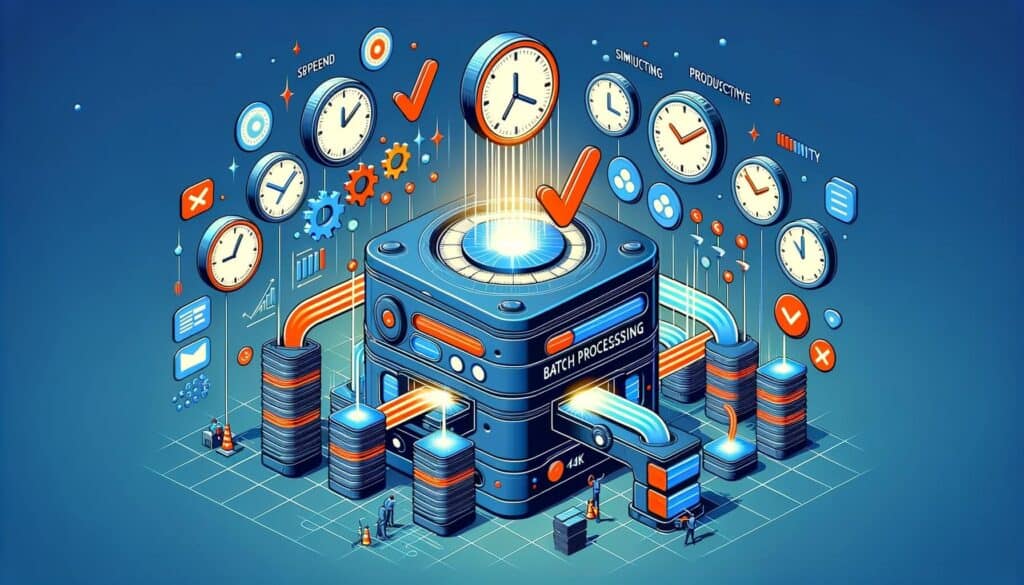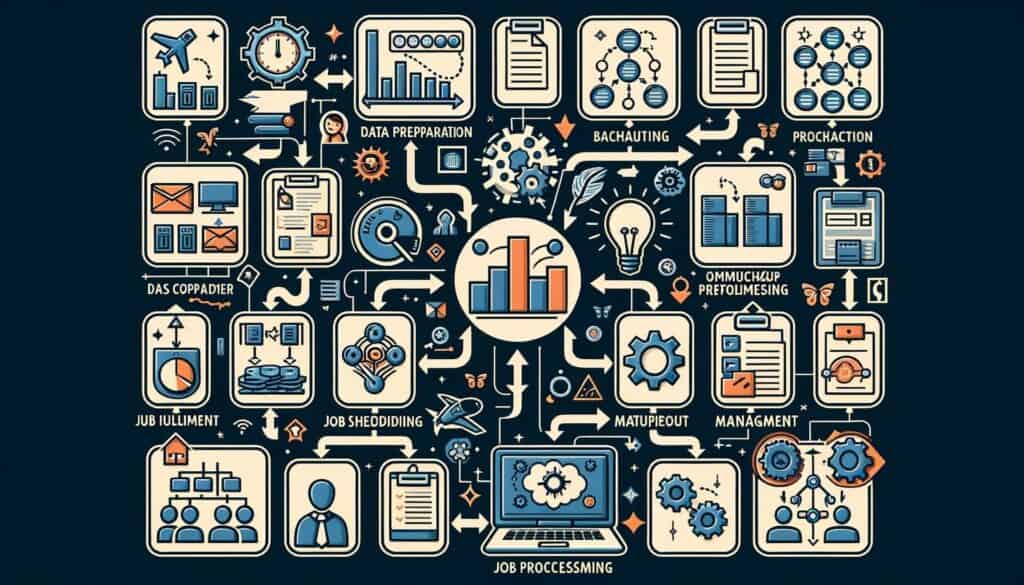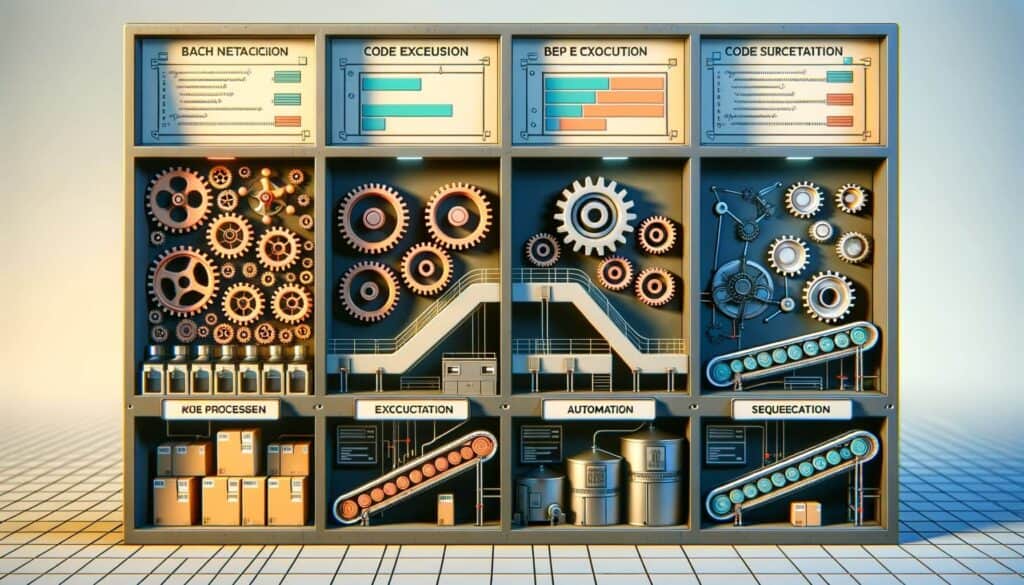
By Mollie Mills January 28, 2025
Batch processing is a method of executing a series of tasks or jobs in a computer system without manual intervention. It involves the processing of a large volume of data or transactions as a group, rather than individually. This approach is widely used in various industries and sectors, including banking, manufacturing, telecommunications, and data processing.
Batch processing is an efficient way to handle repetitive tasks that require minimal user interaction. It allows organizations to automate their business processes, improve productivity, and reduce costs. In this article, we will explore the basics of batch processing, its benefits and advantages, common applications, key components and workflow, different types of batch processing systems, challenges and limitations, best practices, and frequently asked questions.
Understanding the Basics of Batch Processing
Batch processing involves the execution of a series of tasks or jobs in a sequential manner. These tasks are typically performed on a set of data or transactions that are collected over a period of time. The data is processed as a batch, rather than in real-time or on an individual basis. The batch processing workflow typically consists of the following steps:
1. Data Collection: The first step in batch processing is to collect the data or transactions that need to be processed. This can be done through various sources, such as databases, files, or external systems.
2. Data Preparation: Once the data is collected, it needs to be prepared for processing. This may involve cleaning, filtering, sorting, or transforming the data to ensure its quality and consistency.
3. Job Scheduling: After the data is prepared, the next step is to schedule the jobs or tasks for processing. This involves determining the order in which the jobs should be executed and allocating the necessary resources.
4. Job Execution: The scheduled jobs are then executed one by one, following the predefined order. Each job performs a specific task, such as data validation, calculations, or data integration.
5. Error Handling: During the execution of the jobs, errors or exceptions may occur. These errors need to be handled appropriately, either by retrying the job, skipping it, or notifying the user or system administrator.
6. Job Completion and Reporting: Once all the jobs are executed, the batch processing system generates reports or logs to provide information about the status and results of the processing. These reports can be used for monitoring, auditing, or analysis purposes.
Benefits and Advantages of Batch Processing

Batch processing offers several benefits and advantages for organizations. Some of the key benefits include:
1. Efficiency: It allows organizations to process a large volume of data or transactions in a relatively short period of time. This improves efficiency and reduces the time required to complete repetitive tasks.
2. Cost-Effectiveness: By automating the processing of tasks, organizations can reduce the need for manual intervention and human resources. This leads to cost savings and increased productivity.
3. Scalability: Its systems can handle large volumes of data or transactions, making them suitable for organizations with growing data needs. They can be easily scaled up or down to accommodate changing requirements.
4. Error Handling: Its systems provide mechanisms for handling errors or exceptions that may occur during the processing. This ensures that the processing continues smoothly and minimizes the impact of errors on the overall system.
5. Flexibility: It allows organizations to define and customize their own processing rules and workflows. This flexibility enables them to adapt the system to their specific business requirements and processes.
Common Applications of Batch Processing

Batch processing is used in various industries and sectors for a wide range of applications. Some of the common applications include:
1. Data Integration: It is often used for integrating data from multiple sources into a single system or database. This can involve data cleansing, transformation, and consolidation.
2. Billing and Invoicing: Many organizations use it for generating bills and invoices for their customers. This involves processing large volumes of billing data and generating invoices in a batch mode.
3. Report Generation: It is commonly used for generating reports and analytics. This can include financial reports, sales reports, inventory reports, and other types of business intelligence.
4. Data Backup and Recovery: It is often used for performing data backup and recovery operations. This involves copying data from primary storage to secondary storage devices, such as tape drives or cloud storage.
5. Batch Printing: Many organizations use it for printing large volumes of documents, such as invoices, statements, or reports. This allows them to print multiple documents in a single batch, saving time and resources.
Key Components and Workflow of Batch Processing

Batch processing systems consist of several key components that work together to execute the batch jobs. These components include:
1. Job Scheduler: The job scheduler is responsible for managing the execution of batch jobs. It determines the order in which the jobs should be executed, allocates the necessary resources, and monitors the progress of the jobs.
2. Job Queue: The job queue is a data structure that holds the batch jobs waiting to be executed. It maintains the order of the jobs and provides a mechanism for adding, removing, or prioritizing the jobs.
3. Job Control Language (JCL): JCL is a scripting language used to define and control batch jobs. It specifies the input data, processing instructions, and output destinations for each job.
4. Job Execution Environment: The job execution environment provides the necessary resources, such as CPU, memory, and storage, for executing the batch jobs. It ensures that the jobs have access to the required resources and can run efficiently.
5. Error Handling Mechanism: Batch processing systems include mechanisms for handling errors or exceptions that may occur during the processing. This can involve retrying the job, skipping it, or notifying the user or system administrator.
The workflow of batch processing involves the following steps:
1. Job Submission: The user submits the batch jobs to the system for processing. This can be done through a user interface, command line, or automated process.
2. Job Scheduling: The job scheduler receives the submitted jobs and schedules them for execution. It determines the order in which the jobs should be executed based on their priority, dependencies, and available resources.
3. Job Execution: The scheduled jobs are executed one by one, following the predefined order. Each job performs a specific task, such as data validation, calculations, or data integration.
4. Error Handling: During the execution of the jobs, errors or exceptions may occur. These errors are handled by the error handling mechanism, which can retry the job, skip it, or notify the user or system administrator.
5. Job Completion and Reporting: Once all the jobs are executed, the batch processing system generates reports or logs to provide information about the status and results of the processing. These reports can be used for monitoring, auditing, or analysis purposes.
Different Types of Batch Processing Systems

There are different types of batch processing systems, each with its own characteristics and capabilities. Some of the common types include:
1. Mainframe Batch Processing: Mainframe batch processing systems are typically used in large organizations that require high processing capacity and reliability. These systems are designed to handle massive volumes of data and transactions.
2. Distributed Batch Processing: Distributed batch processing systems are used in distributed computing environments, where the processing tasks are distributed across multiple computers or servers. This allows for parallel processing and improved performance.
3. Cloud-Based Batch Processing: Cloud-based batch processing systems leverage the scalability and flexibility of cloud computing to handle large volumes of data or transactions. These systems can be easily scaled up or down based on the processing requirements.
4. Real-Time Batch Processing: Real-time batch processing systems combine the benefits of real-time processing and batch processing. They allow for the processing of data or transactions as they arrive, while still maintaining the advantages of batch processing, such as efficiency and scalability.
Challenges and Limitations of Batch Processing
While batch processing offers several benefits, it also has its challenges and limitations. Some of the common challenges include:
1. Processing Time: It may require a significant amount of time to complete, especially when dealing with large volumes of data or complex processing tasks. This can impact the overall system performance and responsiveness.
2. Data Consistency: It relies on the assumption that the input data is consistent and accurate. However, if the data is not properly validated or cleaned, it can lead to errors or inconsistencies in the output.
3. Error Handling: Handling errors or exceptions that occur during batch processing can be challenging. It requires a robust error handling mechanism that can identify and resolve errors without impacting the overall processing.
4. Scalability: Batch processing systems need to be scalable to handle increasing volumes of data or transactions. However, scaling up the system may require additional resources and infrastructure, which can be costly.
5. Real-Time Processing: It is not suitable for applications that require real-time or near-real-time processing. It is designed for processing tasks that can be deferred and executed in a batch mode.
Best Practices for Effective Batch Processing
To ensure effective batch processing, organizations should follow certain best practices. Some of the key best practices include:
1. Data Validation: It is important to validate the input data before processing it. This can involve checking for data integrity, consistency, and accuracy. Invalid or inconsistent data should be rejected or flagged for further investigation.
2. Error Handling: Batch processing systems should have a robust error handling mechanism that can handle errors or exceptions that occur during the processing. This can involve retrying the job, skipping it, or notifying the user or system administrator.
3. Monitoring and Logging: Organizations should implement monitoring and logging mechanisms to track the progress and results of batch processing. This can help identify performance issues, errors, or bottlenecks in the system.
4. Scalability and Performance: The systems should be designed to handle increasing volumes of data or transactions. This can involve scaling up the system by adding more resources or optimizing the processing algorithms.
5. Automation: Organizations should automate the batch processing tasks as much as possible. This can include automating the job submission, scheduling, execution, and reporting processes. Automation reduces the need for manual intervention and improves efficiency.
Frequently Asked Questions
Q1. What is the difference between batch processing and real-time processing?
Batch processing involves the execution of a series of tasks or jobs in a sequential manner, while real-time processing involves the processing of data or transactions as they arrive. It is suitable for tasks that can be deferred and executed in a batch mode, while real-time processing is used for tasks that require immediate or near-immediate processing.
Q2. What are the benefits of using batch processing?
Batch processing offers several benefits, including improved efficiency, cost-effectiveness, scalability, error handling, and flexibility. It allows organizations to process a large volume of data or transactions in a relatively short period of time, automate repetitive tasks, and reduce costs.
Q3. What are the common applications of batch processing?
Batch processing is used in various industries and sectors for applications such as data integration, billing and invoicing, report generation, data backup and recovery, and batch printing. It is widely used in banking, manufacturing, telecommunications, and data processing.
Q4. What are the key components of a batch processing system?
A batch processing system consists of several key components, including a job scheduler, job queue, job control language (JCL), job execution environment, and error handling mechanism. These components work together to execute the batch jobs in a sequential manner.
Q5. What are the challenges of batch processing?
Batch processing has challenges such as processing time, data consistency, error handling, scalability, and real-time processing. It may require a significant amount of time to complete, especially when dealing with large volumes of data. Data consistency and error handling can be challenging, and the system needs to be scalable to handle increasing volumes of data or transactions.
Conclusion
Batch processing is a method of executing a series of tasks or jobs in a computer system without manual intervention. It offers several benefits, including improved efficiency, cost-effectiveness, scalability, error handling, and flexibility. It is used in various industries and sectors for applications such as data integration, billing and invoicing, report generation, data backup and recovery, and batch printing.
Batch processing systems consist of key components such as a job scheduler, job queue, job control language (JCL), job execution environment, and error handling mechanism. These components work together to execute the batch jobs in a sequential manner. However, It also has its challenges and limitations, such as processing time, data consistency, error handling, scalability, and real-time processing.
To ensure effective batch processing, organizations should follow best practices such as data validation, error handling, monitoring and logging, scalability and performance optimization, and automation. By implementing these best practices, organizations can maximize the benefits of batch processing and improve their overall efficiency and productivity.